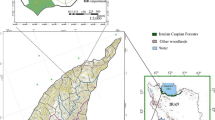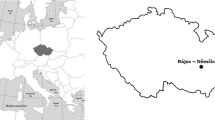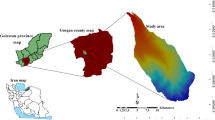Abstract
In this study, the basal area increment models were developed to be both age dependent and independent with a stepwise multiple regression analysis for coppice-originated pure sessile oak stands in the Marmara region, which is located in north-western Turkey. Data was obtained from a total of 73 sample trees, which were sampled from coppice-originated pure sessile oak stands over different growth periods and in different site conditions. The most suitable competition variable was determined by examining the correlations between the 24 competition index values and calculated using different approaches and the basal area increment. The individual tree basal area increment models were obtained as functions of tree size, competition, age, and site characteristics. The most important variables that affect the basal area increment in the age-dependent model were the diameter at breast height (DBH) (36.1%), competition index (26.4%), and age (10%). For the age-independent model, the variables are the competition index (32.6%), DBH (30.3%), and the site index (3%), according to the relative importance values. The age-dependent model explained the increased variation of 10% and predicted a 13% decrease in error in the basal area increment than the age-independent model.





Similar content being viewed by others
References
Adame, P., Hynynen, J., Cañellas, I., & del Río, M. (2008). Individual-tree diameter growth model for rebollo oak (Quercus pyrenaica Willd.) coppices. Forest Ecology and Management, 255(3–4),1011–1022. https://doi.org/10.1016/j.foreco.2007.10.019
Adamec, Z., Kadavý, J., Kneifl, M., Šplíchalová, M., & Klimánek, M. (2014). The response of basal area increment in old sprout-origin sessile oak (Quercus petraea (Matt.) Liebl.) trees during their conversion to a coppice-with-standards. Acta Universitatis Agriculturae et Silviculturae Mendelianae Brunensis, 62(5), 837–847. https://doi.org/10.11118/actaun201462050837
Akalp, T. (1983). Değişik Yaşlı Meşcerelerde Artım ve Büyümenin Simulasyonu. İstanbul Üniversitesi Orman Fakültesi, İstanbul. [In Turkish].
Assmann, E. (1970). The principles of forest yield studies. Pergamon Press, p. 492.
Atalay, İ. (2010). Uygulamalı Klimatoloji. Meta Basım Matbaacılık Hizmetleri, Bornova-İzmir. [In Turkish].
Biging, G. S., & Dobbertin, M. (1995). Evaluation of competition indices in individual tree growth models. Forest Science, 41(2), 360–377. https://doi.org/10.1093/forestscience/41.2.360
Calama, R., & Montero, G. (2005). Multilevel linear mixed model for tree diameter increment in stone pine (Pinus pinea): a calibrating approach. Silva Fennica, 39(1), 37–54. https://doi.org/10.14214/sf.394
Canham, C. D., Papaik, M. J., Uriarte, M., McWilliams, W. H., Jenkins, J. C., & Twery, M. J. (2006). Neighborhood analyses of canopy tree competition along environmental gradients in New England forests. Ecological Applications, 16(2), 540–554. https://doi.org/10.1890/1051-0761(2006)016[0540:NAOCTC]2.0.CO;2
Cannell, M. G. R., Rothery, P., & Ford, E. D. (1984). Competition within stands of Picea sitchensis and Pinus contorta. Annals of Botany, 53(3), 349–362. https://doi.org/10.1093/oxfordjournals.aob.a086699
Cienciala, E., Apltauer, J., Exnerová, Z., & Tatarinov, F. (2008). Biomass functions applicable to oak trees grown in Central-European forestry. Journal of Forest Science, 54(3), 109–120. https://doi.org/10.17221/2906-JFS
Contreras, M. A., Affleck, D., & Chung, W. (2011). Evaluating tree competition indices as predictors of basal area increment in western Montana forests. Forest Ecology and Management, 262(11), 1939–1949. https://doi.org/10.1016/j.foreco.2011.08.031
Coomes, D. A., & Allen, R. B. (2007). Effects of size, competition and altitude on tree growth. Journal of Ecology, 95(5), 1084–1097. https://doi.org/10.1111/j.1365-2745.2007.01280.x
da Cunha, T. A., Finger, C. A. G., & Hasenauer, H. (2016). Tree basal area increment models for Cedrela, Amburana, Copaifera and Swietenia growing in the Amazon rain forests. Forest Ecology and Management, 365, 174–183. https://doi.org/10.1016/j.foreco.2015.12.031
Daniels, R. F., Burkhart, H. E., & Clason, T. R. (1986). A comparison of competition measures for predicting growth of loblolly pine trees. Canadian Journal of Forest Research, 16(6), 1230–1237. https://doi.org/10.1139/x86-218
De Luis, M., Raventos, J., Cortina, J., Moro, M. J., & Bellot, J. (1998). Assessing components of a competition index to predict growth in an even-aged Pinus nigra stand. New Forests, 15(3), 223–242. https://doi.org/10.1023/A:1006507017646
Gea-Izquierdo, G., & Cañellas, I. (2009). Analysis of holm oak intraspecific competition using Gamma regression. Forest Science, 55(4), 310–322. https://doi.org/10.1093/forestscience/55.4.310
Hasenauer, H. (2006). Concepts within tree growth modelling. In: Sustainable forest management-growth models for Europe. Chap. 1. Edited by H. Hasenauer. Springer, Berlin, Germany, pp. 64–70.
Hasenauer, H., & Monserud, R. A. (1996). A crown ratio model for Austrain forests. Forest Ecology and Management, 84, 49–60. https://doi.org/10.1016/0378-1127(96)03768-1
Hegyi, F. (1974). A simulation model for managing jack-pine stands. In: Growth models for tree and stand simulation. Edited by J.Fries. Res. Note No. 30. Royal College of Forestry, Department of Forest Yield Research, Stockholm, Sweden, pp. 74–90.
Hui, G., Wang, Y., Zhang, G., Zhao, Z., Bai, C., & Liu, W. (2018). A novel approach for assessing the neighborhood competition in two different aged forests. Forest Ecology and Management, 422, 49–58. https://doi.org/10.1016/j.foreco.2018.03.045
Jõgiste, K. (2000). A basal area increment model for Norway spruce in mixed stands in Estonia. Scandinavian Journal of Forest Research, 15(1), 97–102. https://doi.org/10.1080/02827580050160529
Keddy, P. A. (1989). Competition. Chapman and Hall.
King, D. A., Davies, S. J., & Noor, N. S. M. (2006). Growth and mortality are related to adult tree size in a Malaysian mixed dipterocarp forest. Forest Ecology and Management, 223(1–3), 152–158. https://doi.org/10.1016/j.foreco.2005.10.066
Lee, W. K., Von Gadow, K., Chung, D. J., Lee, J. L., & Shin, M. Y. (2004). DBH growth model for Pinus densiflora and Quercus variabilis mixed forests in central Korea. Ecological Modelling, 176(1–2), 187–200. https://doi.org/10.1016/j.ecolmodel.2003.11.012
Lorimer, C. G. (1983). Tests of age-independent competition indices for individual trees in natural hardwood stands. Forest Ecology and Management, 6(4), 343–360. https://doi.org/10.1016/0378-1127(83)90042-7
Mailly, D., Turbis, S., & Pothier, D. (2003). Predicting basal area increment in a spatially explicit, individual tree model: a test of competition measures with black spruce. Canadian Journal of Forest Research, 33(3), 435–443. https://doi.org/10.1139/x02-122
Marklund, L. G. (1987). Biomass functions for Norway spruce (Picea abies (L.) Karst.) in Sweden. [Report.] Umea, Department of Forest Survey, Swedish University of Agricultural Sciences, 43.
Martin, G. L., & Ek, A. R. (1984). A comparison of competition measures and growth models for predicting plantation red pine diameter and height growth. Forest Science, 30(3), 731–743. https://doi.org/10.1093/forestscience/30.3.731
Matsushita, M., Takata, K., Hitsuma, G., Yagihashi, T., Noguchi, M., Shibata, M., & Masaki, T. (2015). A novel growth model evaluating age–size effect on long-term trends in tree growth. Functional Ecology, 29(10), 1250–1259. https://doi.org/10.1111/1365-2435.12416
Monserud, R. A., & Sterba, H. (1996). A basal area increment model for individual trees growing in even-and uneven-aged forest stands in Austria. Forest Ecology and Management, 80(1–3), 57–80. https://doi.org/10.1016/0378-1127(95)03638-5
OGM. (2012). Türkiye Orman Varlığı. CTA Tanıtım Limited, Ankara. [In Turkish].
Özdemir, G. A. (2013). Trakya meşe ormanlarında artım ve büyüme ilişkileri. Ph.D. Thesis, Istanbul University. [In Turkish].
Peng, C. (2000). Growth and yield models for uneven-aged stands: past, present and future. Forest Ecology and Management, 132(2–3), 259–279. https://doi.org/10.1016/S0378-1127(99)00229-7
Pretzsch, H. (2009). Forest dynamics, growth and yield: from measurement to model. Springer.
R Core Team. (2019). R: a language and environment for statistical computing. R Foundation for Statistical Computing, Vienna, Austria. URL https://www.R-project.org/
Radtke, P. J., Westfall, J. A., & Burkhart, H. E. (2003). Conditioning a distance-dependent competition index to indicate the onset of inter-tree competition. Forest Ecology and Management, 175(1–3), 17–30. https://doi.org/10.1016/S0378-1127(02)00118-4
Şahin, A. (2014). Marmara bölgesindeki meşe ormanları ve koruya tahvil (dönüştürme) uygulamaları-1. Orman ve Av, Türkiye Ormancılar Derneği Süreli Yayını, Sayı: 2014/4, 15–31, Ankara. [In Turkish].
Şahin, A. (2020). Marmara bölgesindeki sapsız meşe (Quercus petraea (mattuschka) liebl.) meşcerlerinin hasılatı ve amenajman esasları. Ph.D. Thesis, İstanbul University -Cerrahpaşa. [In Turkish].
Schroeder, J. (2000). Comparison of a spatial and a non-spatial model for predicting basal area increment of individual maritime pine trees in Galicia. In: Schroeder, J. (Ed.), Analyse der Wuchsdynamik von Pinus pinaster Ait. Nordwest-Spanien.Dissertation in Goettingen.
Sterba, H., Blab, A., & Katzensteiner, K. (2002). Adapting an individual tree growth model for Norway spruce (Picea abies L. Karst.) in pure and mixed species stands. Forest Ecology and Management, 159(1–2), 101–110. https://doi.org/10.1016/S0378-1127(01)00713-7
Szwagrzyk, J., Szewczyk, J., & Maciejewski, Z. (2012). Shade-tolerant tree species from temperate forests differ in their competitive abilities: a case study from Roztocze, south-eastern Poland. Forest Ecology and Management, 282, 28–35. https://doi.org/10.1016/j.foreco.2012.06.031
Tenzin, J., Tenzin, K., & Hasenauer, H. (2017). Individual tree basal area increment models for broadleaved forests in Bhutan. Forestry, 90(3), 367–380. https://doi.org/10.1093/forestry/cpw065
Timilsina, N., & Staudhammer, C. L. (2013). Individual tree-based diameter growth model of slash pine in Florida using nonlinear mixed modeling. Forest Science, 59(1), 27–37. https://doi.org/10.5849/forsci.10-028
Tomé, M., & Burkhart, H. E. (1989). Distance-dependent competition measures for predicting growth of individual trees. Forest Science, 35(3), 816–831. https://doi.org/10.1093/forestscience/35.3.816
Uzoh, F. C. C., & Oliver, W. W. (2008). Individual tree diameter increment model for managed even-aged stands of ponderosa pine throughout the western United States using a multilevel linear mixed effects model. Forest Ecology and Management, 256(3), 438–445. https://doi.org/10.1016/j.foreco.2008.04.046
Vanclay, J.K. (1988). A stand growth model for cypress pine. In: J.W. Leech, R.E. McMurtrie, P.W. West, R.D. Spencer and B.M. Spencer (eds) Modelling Trees, Stands and Forests. Proc. Workshop, Aug. 1985, Univ. of Melbourne. School of Forestry, Univ. of Melbourne, Bulletin No. 5, pp. 310–332.
Vanclay, J. K. (1994). Modelling forest growth and yield: applications to mixed tropical forests. CAB International.
Van Laar, A. (1991). Forest biometry. University of Stellenbosch, p. 590.
Wang, W., Chen, X., Zeng, W., Wang, J., & Meng, J. (2019). Development of a mixed-effects individual-tree basal area increment model for oaks (Quercus spp.) considering forest structural diversity. Forests, 10(6), 474. https://doi.org/10.3390/f10060474
Wang, M., Zhao, Y., Zhen, Z., & Jin, X. (2020). Individual-tree diameter growth model for Korean pine plantations based on optimized interpolation of meteorological variables. Journal of Forestry Research, 1-18. https://doi.org/10.1007/s11676-020-01177-9
West, P. W. (1980). Use of diameter increment and basal area increment in tree growth studies. Canadian Journal of Forest Research, 10(1), 71–77. https://doi.org/10.1139/x80-012
WinDENDROTM. (2021). Tree-ring and wood density analyser optimised for optical scanners. https://regentinstruments.com/assets/images_windendro/WinDENDRO2021.pdf
Wykoff, W. R. (1990). A basal area increment model for individual conifers in the northern Rocky Mountains. Forest Science, 36(4), 1077–1104. https://doi.org/10.1093/forestscience/36.4.1077
Zhang, Z., Papaik, M. J., Wang, X., Hao, Z., Ye, J., Lin, F., & Yuan, Z. (2017). The effect of tree size, neighborhood competition and environment on tree growth in an old-growth temperate forest. Journal of Plant Ecology, 10(6), 970–980. https://doi.org/10.1093/jpe/rtw126
Zhao, L., Li, C., & Tang, S. (2013). Individual-tree diameter growth model for fir plantations based on multi-level linear mixed effects models across southeast China. Journal of Forest Research, 18(4), 305–315. https://doi.org/10.1007/s10310-012-0352-3
Acknowledgements
I would like to thank Abbas Şahin from Marmara Forestry Research Institute his assistance in obtaining the data of this study.
Author information
Authors and Affiliations
Corresponding author
Additional information
Publisher's Note
Springer Nature remains neutral with regard to jurisdictional claims in published maps and institutional affiliations.
Rights and permissions
About this article
Cite this article
Ozdemir, E. Individual tree basal area increment model for sessile oak (Quercus petraea (Matt.) Liebl.) in coppice-originated stands. Environ Monit Assess 193, 357 (2021). https://doi.org/10.1007/s10661-021-09128-5
Received:
Accepted:
Published:
DOI: https://doi.org/10.1007/s10661-021-09128-5




